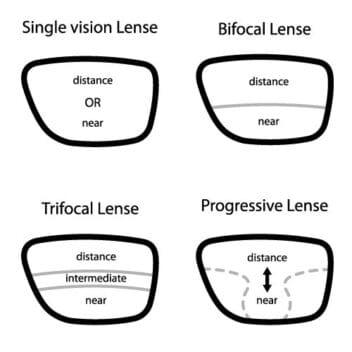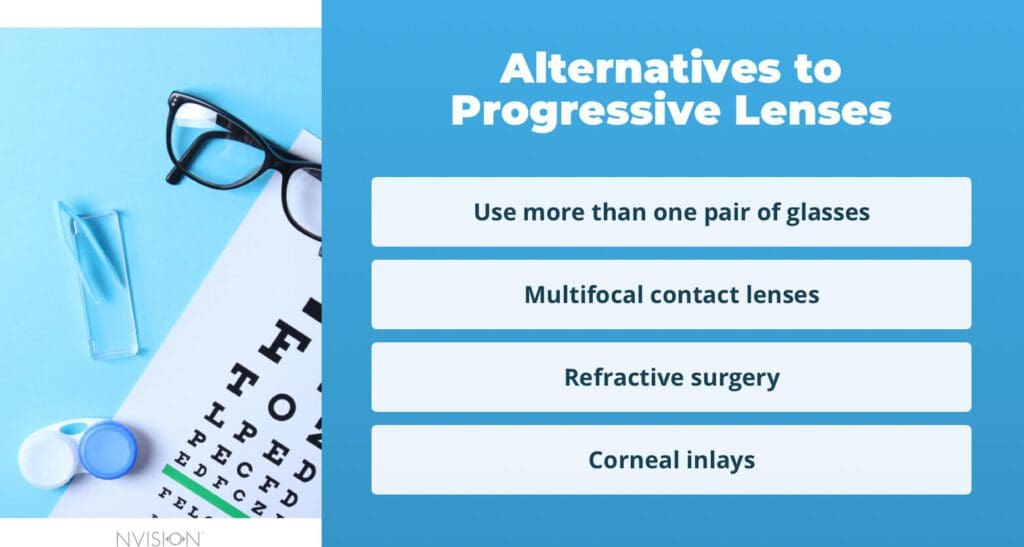Further Reading
Are There Problems With Progressive Glasses Lenses?
Home / Everything About Glasses /
Last Updated:
Common problem with progressive lenses includes a lengthy adjustment period that can lead to symptoms like tired eyes, headaches, and even nausea. Additionally, progressive lenses can cause a “swim effect,” affecting peripheral vision, and are typically more expensive than traditional bifocals. Despite these issues, they remain a popular choice for correcting multiple refractive errors in one lens, offering a seamless transition without visible lines.
Possible Issues

Just like with regular bifocal or multifocal lenses, progressive glasses lenses can take some time to get used to. It can take several weeks to a month to fully adjust to progressive lenses.
The long adjustment period can lead to the following:
- Tired eyes
- Eyestrain
- Headaches
- Nausea
- Dizziness
- Frustration
Some people may not be able to handle the adjustment period. People who suffer from headaches, nausea, vertigo, or are prone to motion sickness may not be able to adjust to progressive lenses.
Progressive glasses lenses can cause a “swim effect,” which impacts peripheral vision and can distort vision at the edges of the lenses. This may not go away with time like the other difficulties might.
Another con of progressive lenses is the cost. These specialty glasses lenses can cost upwards of $100 more than typical bifocals, and insurance may not cover them.
Table of Contents
Progressive lenses, often called “no-line” multifocals, are a type of glasses lens that is designed to correct presbyopia (age-induced farsightedness), myopia (farsightedness), and middle-vision all at once.
Contrary to traditional bifocals, which only correct for two types of refractive errors at a time, or even other multifocal lenses, progressive lenses do not have the bisecting and visual line between the variable corrective portions of the lens. Instead, the transition is more seamless — at least to the naked eye. This can be appealing both for convenience and aesthetics.
These lenses can be very difficult to get used to, and they can even lead to feelings of physical illness.
Alternatives to progressive glasses lenses include multifocal contact lenses, more than one pair of glasses for different refractive errors, or corrective surgery.
Talk to your eye care health provider to determine if progressive lens are a good option for you or if there is a better alternative.
Talk to your eye care health provider to determine if progressive lens are
a good option for you or if there is a better alternative.

What Are Progressive Glasses Lenses?

People over age 40 often struggle with presbyopia and additional refractive errors, simultaneously requiring bifocal or multifocal lenses.
Traditional bifocals have a visible line in the middle of the lens splitting one part from the other. Progressive glasses lenses are an advancement over traditional “lined” multifocal lenses as they have no discernible lines.
You deserve clear vision. We can help.
With 135+ locations and over 2.5 million procedures performed, our board-certified eye surgeons deliver results you can trust. Your journey to better vision starts here.
Progressive glasses lenses provide vision corrections at three different levels: up close for reading at the bottom of the lens, middle-vision clarity just above this, and clarity for seeing far away when looking straight at something.
These progressive glasses lenses, or “no-line” multifocal lenses, offer a more gradual change between corrective portions of the lens. They can provide a full range of vision clarity, all in one lens.
Optimal Uses

The National Eye Institute (NEI) publishes that presbyopia, which is
difficulty seeing things up close and trouble with reading, is often accompanied by other refractive errors at the same time. Someone suffering from presbyopia can still struggle with seeing things far away too — known as myopia, or nearsightedness.
When you have more than one refractive error, multifocal lenses can be beneficial. Progressive lenses are advanced multifocals.
Thanks to their lack of visible lines, they can be more aesthetically pleasing. It can help a person to feel as if they look younger than when wearing traditional lined bifocal glasses. It can also be more convenient than having to change glasses between activities and carrying multiple pairs around.
These lenses are optimally suited for people who can be patient enough to allow their eyes time to adjust. If you do not struggle with other medical issues that may make you more prone to nausea, headaches, or motion sickness, these specialized lenses may work for you.

Alternatives to Progressive Glasses

If you suffer from presbyopia and additional refractive errors, bifocals, multifocals, and progressive lenses are options for treatment, the American Academy of Ophthalmology (AAO) explains.
You can always use more than one pair of glasses to treat each refractive error. For instance, you may use reading glasses when looking at things up close and traditional glasses to correct nearsightedness, farsightedness, or astigmatism.
There are alternatives to multiple pairs of glasses as well. Instead of eyeglasses, you can get multifocal contact lenses.
Refractive surgery or corneal inlays are additional treatment options. Refractive surgery can correct one eye to see up close and the other to see far away — called monovision correction. This can also require an adjustment period, and it is not for everyone.
Corneal inlays, or implants, can correct for presbyopia directly by surgically placing a small device in the front of the eye that can correct up-close vision. This is a minor and minimally invasive surgical procedure that may be beneficial for improving presbyopia, but you will still need corrective lenses for other refractive errors.
Your eye health care provider can help you to decide which treatment may be best suited for your eyes and your specific tolerance level. Progressive glasses lenses do have benefits, but they can be hard to get used to and may not be ideal for everyone.
You deserve clear vision. We can help.
With 135+ locations and over 2.5 million procedures performed, our board-certified eye surgeons deliver results you can trust. Your journey to better vision starts here.
References
- Progressive Lenses (No-Line Multifocals). (August 2018). All About Vision.
- Are Progressive Lenses Right for You? (December 2018). WebMD
- Facts About Presbyopia. (October 2010). National Eye Institute (NEI).
- Presbyopia Treatment. (February 2019). American Academy of Ophthalmology (AAO).
This content is for informational purposes only. It may have been reviewed by a licensed physician, but is not intended to serve as a substitute for professional medical advice. Always consult your healthcare provider with any health concerns. For more, read our Privacy Policy and Editorial Policy.